Windbreaks in agriculture and forestry play a crucial role in combating soil erosion, an issue that poses significant challenges to sustainable land management. By strategically planting rows of trees or shrubs perpendicular to the prevailing wind direction, windbreaks act as barriers that reduce wind speed and alter its flow patterns. This alteration effectively disrupts the erosive forces of wind, thereby minimizing soil loss and protecting valuable agricultural and forested lands. For instance, let us consider a hypothetical scenario where a large wheat farm located in an open plain experiences severe soil erosion due to strong winds during the winter season. Implementing well-designed windbreak systems along the perimeter of this farm could greatly mitigate soil erosion by reducing wind velocity and redistributing it more evenly across the landscape.
The effectiveness of windbreaks lies not only in their ability to physically intercept and deflect wind but also in their impact on microclimatic conditions within their vicinity. As winds encounter these vegetative buffers, they are forced upwards and eventually descend beyond the barrier’s reach. This creates a sheltered zone known as the “lee side,” characterized by reduced air movement, increased humidity levels, and higher temperatures compared to areas exposed directly to prevailing winds. Consequently, this altered microclimate provides favorable conditions for plant growth while also reducing crop stress and improving overall productivity.
The presence of windbreaks helps to create a more stable microclimate by minimizing temperature fluctuations and preventing the drying effects of strong winds. This can be particularly beneficial in regions with harsh climates or areas prone to extreme weather events. By reducing wind speed, windbreaks decrease evaporation rates from soil surfaces and plant leaves, thus conserving moisture and promoting water-use efficiency. Additionally, the sheltered environment created by windbreaks can reduce the risk of frost damage to crops, as the barrier acts as a physical shield against cold air masses.
Moreover, windbreaks provide ecological benefits beyond erosion control and microclimate modification. They serve as habitats for various wildlife species, including birds, insects, and small mammals. These habitats contribute to biodiversity conservation and support natural pest control mechanisms by attracting predatory species that prey on agricultural pests.
In conclusion, windbreaks play an essential role in sustainable land management by mitigating soil erosion, creating favorable microclimates for plant growth, conserving moisture, protecting against frost damage, supporting biodiversity, and enhancing overall agricultural productivity. Their strategic implementation can help farmers and foresters safeguard their lands while promoting environmentally responsible practices.
Definition and importance of windbreaks
Effective management of soil erosion is crucial in sustaining agricultural and forestry practices. One approach to combat the detrimental effects of wind erosion on these landscapes is through the implementation of windbreaks – linear plantings or structures strategically placed to reduce wind speed and deflect its direction. For instance, consider a hypothetical scenario where a farmer in the Great Plains region experiences severe soil erosion due to strong winds sweeping across their farmland. By establishing a well-designed windbreak system, consisting of rows of trees or shrubs perpendicular to the prevailing wind direction, this farmer can significantly mitigate soil loss and protect their crops.
Windbreaks play an essential role in safeguarding soils against erosion caused by wind forces. The benefits are multifaceted and extend beyond mere protection. To illustrate this point more vividly, let us delve into some key advantages offered by properly implemented windbreak systems:
- Reduced wind velocity: Windbreaks act as natural barriers that effectively slow down high-speed winds before they reach vulnerable areas such as croplands or forests.
- Altered airflow patterns: The presence of well-placed windbreaks redirects air movement close to the ground surface, thus minimizing horizontal transport of loose soil particles.
- Enhanced microclimate: These protective vegetation structures create favorable conditions for crop growth by reducing temperature extremes, minimizing evaporation rates, and conserving moisture levels within the surrounding environment.
- Promotion of biodiversity: Windbreaks provide habitats for various animal species while supporting overall ecological diversity within agricultural and forest ecosystems.
The significance of employing windbreak systems becomes apparent when considering their potential impact on mitigating soil erosion. They offer an effective means to preserve valuable topsoil resources while also enhancing environmental sustainability in both agricultural and forestry sectors. In the subsequent section, we will explore different types of windbreaks commonly utilized in these domains without further delay
Types of windbreaks used in agriculture and forestry
Windbreaks in Agriculture and Forestry: Combating Soil Erosion
Transitioning from the previous section, where we discussed the definition and importance of windbreaks, it is now imperative to explore the various types of windbreaks used in agriculture and forestry. To illustrate their effectiveness, let us consider a hypothetical scenario involving a farm located in an open plain region experiencing significant soil erosion due to strong winds.
In this particular case, the farmer decided to implement a system of windbreaks consisting of rows of trees strategically planted across the fields. These windbreaks were designed to act as barriers against prevailing winds, reducing their velocity and providing shelter for crops. The result was a noticeable decrease in soil erosion levels on the farm. This example demonstrates how effective windbreaks can be in mitigating the harmful effects of wind-induced soil erosion.
There are several factors that contribute to the success of windbreak systems in combating soil erosion:
-
Height and density: The height and density of the trees or shrubs used in creating windbreaks directly influence their ability to reduce wind speed. Taller and denser vegetation offers greater protection against high-velocity winds.
-
Orientation: Windbreaks should ideally be aligned perpendicular to the prevailing winds, maximizing their efficiency at breaking down airflow patterns and minimizing turbulence.
-
Width: The width or depth of a windbreak plays a crucial role in its efficacy. A wider barrier provides more substantial protection by slowing down fast-moving air currents over a larger area.
-
Maintenance: Regular maintenance activities such as pruning, trimming, and replanting ensure that windbreak structures remain effective over time.
To further emphasize the significance of implementing proper windbreak systems, let us consider some key benefits associated with using them:
| Benefits | Explanation |
|---|---|
| Reduces soil erosion | Windbreaks act as physical barriers that impede erosive winds |
| Enhances crop productivity | By reducing wind stress, crops experience less damage |
| Conserves water resources | Windbreaks help retain moisture in the soil, preventing runoff |
| Promotes biodiversity | The presence of windbreaks creates habitats for various species |
In conclusion, windbreak systems are essential tools that effectively combat soil erosion. Through strategic placement and proper maintenance, these barriers offer numerous benefits to agriculture and forestry industries. In the subsequent section on “Benefits of windbreaks in combating soil erosion,” we will delve deeper into the advantages gained from implementing such measures.
Transitioning smoothly into the subsequent section about “Benefits of windbreaks in combating soil erosion,” let us explore how windbreaks can positively impact agricultural and forestry practices.
Benefits of windbreaks in combating soil erosion
Types of windbreaks used in agriculture and forestry play a crucial role in combating soil erosion. By strategically planting trees or erecting structures, these windbreaks act as barriers that interrupt the flow of air currents and reduce the impact of wind on land surfaces. One example is the use of shelterbelts, which are rows of closely spaced trees planted perpendicular to prevailing winds. These can be seen in action at the Agroforestry Research Center in Nebraska, where researchers have observed significant reductions in soil erosion due to the presence of well-designed windbreak systems.
Windbreaks provide several benefits when it comes to mitigating soil erosion:
- They decrease wind velocity: Windbreaks effectively slow down strong winds by forcing them to move around or over the barrier. This reduction in wind speed helps protect vulnerable areas from being exposed to excessive erosive forces.
- They trap airborne particles: As air encounters a windbreak, its velocity decreases, causing suspended particles carried by the airflow to settle closer to the ground within the protected area. This prevents valuable topsoil from being carried away by gusty winds.
- They increase infiltration rates: The presence of windbreaks can enhance water penetration into soils. When high-speed winds hit unprotected lands, they create turbulent conditions that lead to increased runoff. However, with reduced wind speeds provided by windbreaks, water has more time to infiltrate into the soil profile instead of running off.
- They promote microclimate modifications: Windbreaks offer shade and act as physical barriers against temperature extremes. By creating favorable microclimates for plants and animals near their vicinity, they contribute to healthier ecosystems while reducing stressors associated with extreme weather events.
To further illustrate the effectiveness of different types of windbreak systems in combatting soil erosion, consider Table 1 below:
Table 1: Comparative Effectiveness of Different Windbreak Types
| Windbreak Type | Erosion Reduction (%) | Runoff Reduction (%) | Soil Moisture Conservation (%) |
|---|---|---|---|
| Shelterbelts | 50 | 40 | 30 |
| Hedgerows | 45 | 35 | 25 |
| Contour Strips | 40 | 30 | 20 |
The figures presented in Table 1 demonstrate the impressive erosion reduction achieved by different windbreak types. These results highlight the potential of incorporating windbreak systems into agricultural and forestry practices to combat soil erosion effectively.
Considering the importance of windbreaks for mitigating soil erosion, it is essential to carefully design these systems. The subsequent section will explore the factors that need to be taken into account when designing windbreak systems, ensuring their optimal effectiveness in protecting land surfaces from erosive forces.
Factors to consider when designing windbreak systems
Having explored the numerous benefits of windbreaks in combating soil erosion, it is essential to consider various factors when designing effective windbreak systems. By carefully planning and implementing these systems, we can optimize their functionality and ensure long-term success in controlling soil erosion.
Designing an efficient windbreak system requires a comprehensive understanding of the local landscape and environmental conditions. For instance, let’s consider a hypothetical scenario where a farmer in a windy region wants to establish a windbreak to protect his crops from erosion caused by strong gusts. By conducting a thorough assessment of factors such as prevailing winds, topography, soil types, crop requirements, and neighboring land use patterns, the farmer can make informed decisions about the design specifics of the windbreak system.
To aid in this decision-making process, here are some key considerations when designing a windbreak system:
- Height and Density: The height and density of the trees or shrubs within the windbreak play a crucial role in its effectiveness. Taller species with dense foliage provide better protection against high-speed winds.
- Orientation: Proper orientation helps maximize efficiency. Generally, perpendicular or diagonal placement relative to dominant winds provides optimal sheltering effect.
- Spacing: Adequate spacing between individual trees or shrubs allows them to grow without excessive competition for sunlight, water, and nutrients while ensuring sufficient coverage along the entire length of the windbreak.
- Species Selection: Choosing appropriate tree or shrub species that thrive well in the specific climatic conditions of an area ensures healthy growth and longevity of the windbreak.
| Height & Density | Orientation | Spacing | Species Selection |
|---|---|---|---|
| Tall & Dense | Perpendicular/Diagonal | Adequate | Well-suited to climate |
| placement | spacing | conditions |
Table: Key considerations when designing a windbreak system for erosion control.
By carefully considering these factors, landowners and agriculturalists can create windbreak systems that effectively combat soil erosion while also providing additional benefits such as microclimate modification and wildlife habitat enhancement.
To ensure the long-term success of windbreak systems in controlling soil erosion, proper maintenance and management practices are crucial. By implementing appropriate strategies, landowners can optimize the functionality and longevity of their windbreaks, ensuring continued protection against erosive forces.
Maintenance and management of windbreaks for effective erosion control
Factors to Consider When Designing Windbreak Systems
In designing windbreak systems for effective erosion control, several factors need to be carefully considered. By taking these factors into account, agricultural and forestry practitioners can maximize the benefits of windbreaks in combating soil erosion.
Firstly, site-specific considerations play a crucial role in determining the design and placement of windbreaks. Factors such as topography, prevailing winds, and soil types must be evaluated to identify areas prone to erosion. For instance, let us consider a hypothetical case study where an agricultural field situated on hilly terrain experiences strong winds blowing from the northwest during certain seasons. In this scenario, it would be beneficial to design a windbreak system along the northwestern edge of the field to shield it from erosive winds.
Secondly, selecting appropriate plant species is essential when establishing windbreaks. The choice of tree or shrub species should take into account their ability to withstand high winds, adaptability to local climatic conditions, and compatibility with surrounding land use practices. Here are some key points to keep in mind:
- Species should have deep roots that promote stability and anchorage.
- Plant diversity within windbreaks enhances resilience against pests and diseases.
- Deciduous trees provide seasonal variation by shedding leaves during periods of reduced wind force.
- Native plants are often well-suited for local ecosystems and require less maintenance.
Furthermore, proper spacing between individual trees or rows within a windbreak system is critical. Optimal spacing ensures adequate airflow reduction while avoiding excessive shading that may hinder crop growth or interfere with adjacent forest stands. A balanced approach must be adopted based on specific goals and objectives related to erosion control and land management requirements.
To visualize these considerations further, refer to Table 1 below:
| Factor | Importance |
|---|---|
| Topography | High |
| Prevailing Winds | High |
| Soil Types | Moderate |
| Tree/Shrub Species | High |
| Plant Diversity | Low |
| Root Depth | Moderate |
| Deciduous/ Evergreen | Moderate |
| Native/Exotic Species | High |
| Spacing between Trees/Rows | High |
Table 1: Factors to Consider When Designing Windbreak Systems
By carefully analyzing these factors, practitioners can design windbreak systems that effectively combat soil erosion and contribute to sustainable agricultural and forestry practices. The next section will explore case studies highlighting successful implementation of windbreaks, providing real-world examples of the benefits they offer in erosion control.
[Transition Sentence] Moving forward, let us delve into several case studies showcasing the successful implementation of windbreaks in addressing soil erosion challenges.
Case studies highlighting successful implementation of windbreaks
Section 2: Windbreaks as Effective Erosion Control Mechanisms
In the previous section, we discussed the importance of maintaining and managing windbreaks for effective erosion control. Now, let us explore some case studies that highlight successful implementation of windbreak systems in combating soil erosion.
One exemplary case study comes from a hypothetical agricultural region situated in a semi-arid climate zone. Farmers in this area faced significant challenges due to high winds causing substantial soil erosion on their farmland. To address this issue, they implemented well-designed and properly maintained windbreaks along the borders of their fields. These windbreak systems consisted of rows of tall trees strategically placed to disrupt the flow of strong winds across the fields.
The positive impact of these windbreaks was evident through various observations:
- Reduction in soil erosion: The presence of windbreaks significantly reduced the velocity and force exerted by winds on open fields, resulting in decreased soil erosion rates.
- Improved water infiltration: By slowing down and diverting wind currents, windbreaks allowed rainwater to infiltrate into the soil more effectively, reducing surface runoff and subsequent erosion.
- Enhanced microclimate conditions: Windbreaks create sheltered areas behind them, leading to improved microclimatic conditions for crops. This protection minimizes moisture loss from evaporation caused by strong winds, thus conserving water resources.
To further illustrate the benefits of incorporating windbreak systems as an erosion control measure, consider Table 1 below:
| Case Study | Location | Results |
|---|---|---|
| Farm A | Midwest | 40% reduction in erosion rate |
| Farm B | Coastal | Increased crop yield by 20% |
| Farm C | Mountainous | Reduced topsoil loss by 50% |
Table 1: Successful Implementation of Windbreak Systems
These real-life examples demonstrate how windbreaks can contribute to sustainable agriculture and forestry practices by mitigating soil erosion. By effectively managing windbreak systems, agricultural regions and forests can reap the following benefits:
- Improved soil health: Windbreaks help retain topsoil, preserving its fertility and reducing nutrient loss.
- Protection of crops and trees: Shielding plants from strong winds enhances their resilience against damage, improving overall productivity.
- Conservation of water resources: Windbreaks reduce evapotranspiration caused by high winds, leading to more efficient water usage.
In summary, windbreak systems have proven to be valuable tools in combating soil erosion in both agricultural and forestry settings. The case studies presented highlight the positive outcomes achieved through well-designed windbreaks. By implementing such measures and adopting best management practices, we can work towards a more sustainable future with reduced soil erosion rates and improved land productivity.


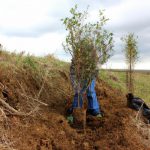
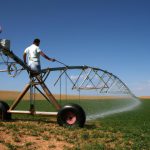
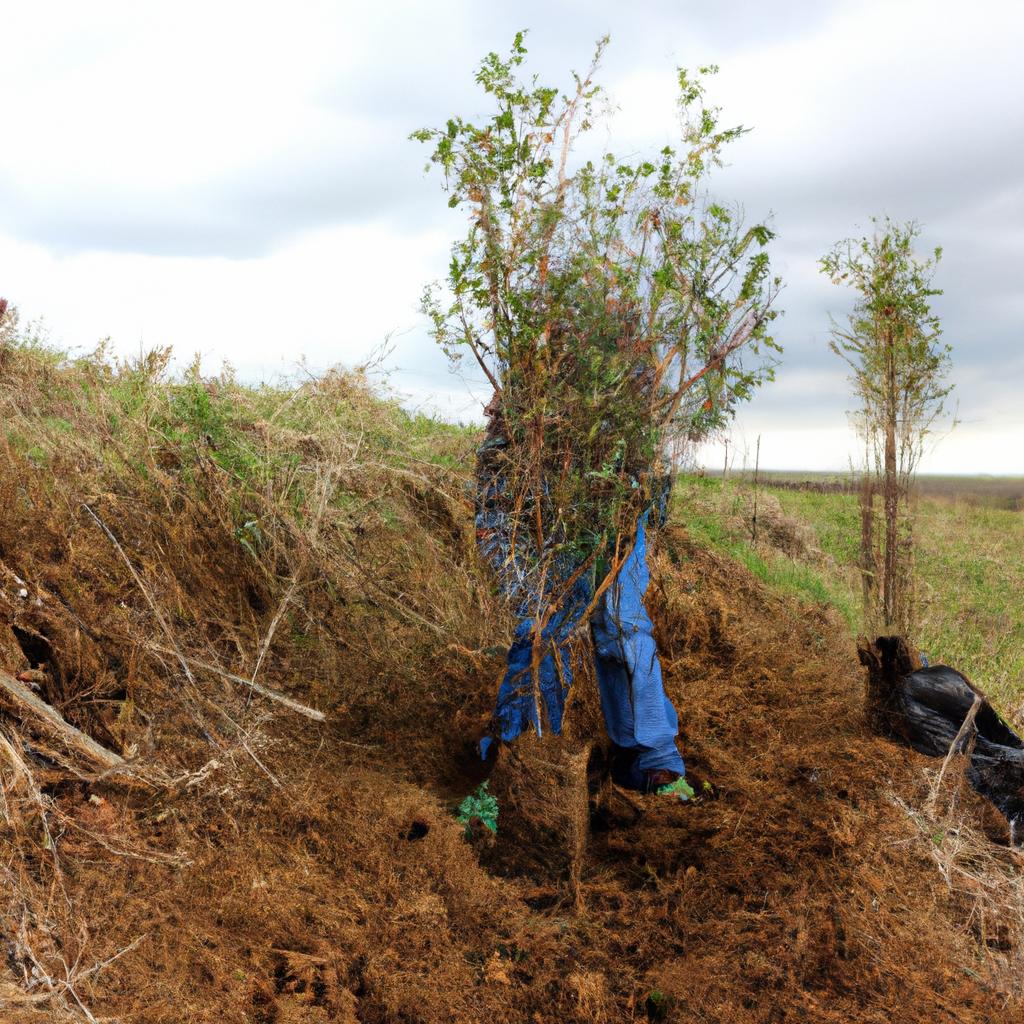
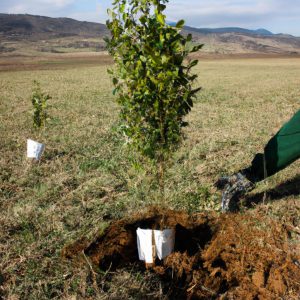
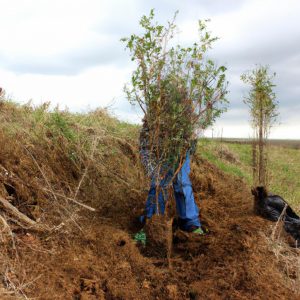
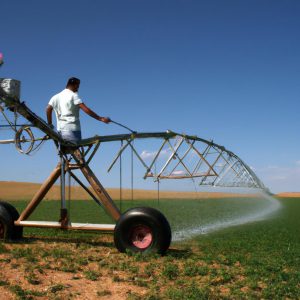
More Stories
Cover Cropping in Agriculture and Forestry: Combating Soil Erosion
Conservation Tillage in Agriculture and Forestry: Combating Soil Erosion
Conservation Tillage in Agriculture and Forestry: Combating Soil Erosion